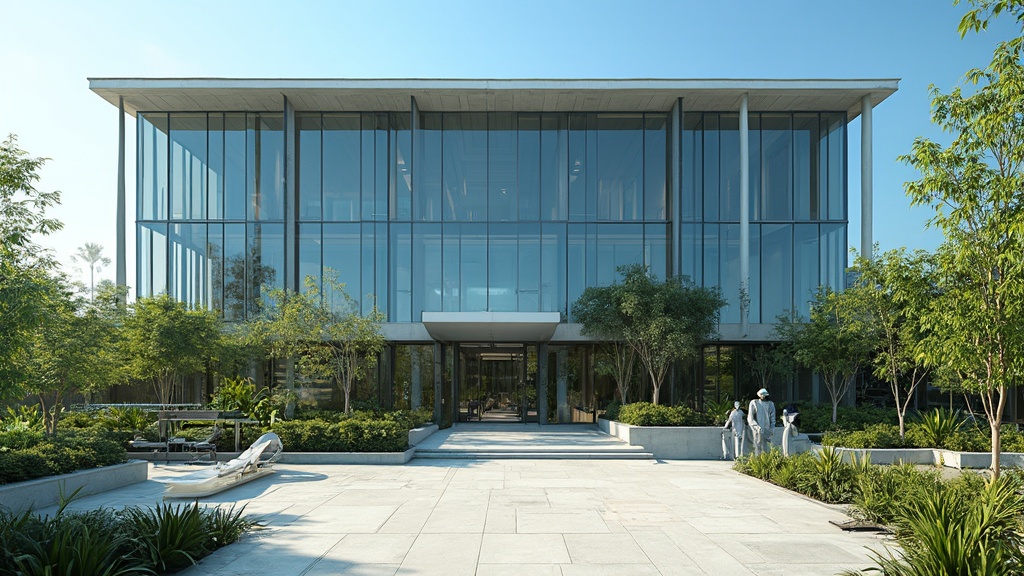Introduction
The evolution of modern office exterior design reflects a dynamic interplay between aesthetic innovation and functional sustainability. As organizations strive to create work environments that foster productivity and collaboration, the architectural landscape has transformed, embracing clean lines, expansive glass facades, and eco-friendly materials. This article delves into the defining characteristics and emerging trends within this realm, exploring how technology and sustainability shape contemporary office designs.
By examining the pivotal role of 3D renderings and sustainable practices, it highlights how architects can effectively visualize and implement their visions, ensuring that modern workspaces not only meet the demands of today’s workforce but also contribute positively to the environment.
Defining Modern Office Exterior Design
Contemporary workspace exterior configuration includes the architectural method and aesthetic factors that influence the facades and overall look of modern building structures. Characterized by clean lines, open areas, and innovative materials, contemporary workplace layouts prioritize functionality and sustainability. This approach enhances the visual appeal of office buildings while addressing the evolving needs of the workforce and fostering environments that promote productivity and collaboration.
To effectively showcase these designs, exterior illustrations play a pivotal role; they illuminate the interplay of natural lighting, detailed landscaping, and the visual characteristics of building materials, providing a comprehensive contextual visualization.
By leveraging specialized 3D rendering services at J. Scott Smith Visual Designs, architects can ensure their visions are developed and presented with precision, leading to project success through realistic and impactful visualizations.
Key Features and Trends in Modern Office Exteriors
Key features of contemporary office exteriors include:
- Large glass windows that promote natural light
- Green roofs that enhance sustainability
- Innovative materials such as metal and composite cladding
Trends like:
- Biophilic design—incorporating natural elements into architecture
- Adaptive reuse, which repurposes existing structures for modern use
are gaining traction.
Initial conceptual illustrations offer swift visualizations of these concepts, enabling prompt feedback and modifications. Furthermore, 3D exterior visualization services enhance architectural planning by offering stakeholders a clear view of the project’s evolution, drastically reducing the chances of costly alterations.
For instance, integrating outdoor spaces like terraces and gardens not only enhances aesthetics but also creates multifunctional areas for relaxation and informal meetings.
Furthermore, contemporary workplace layouts emphasize energy efficiency, incorporating solar panels and sophisticated HVAC systems intended to minimize the environmental impact.
These characteristics collectively contribute to creating dynamic and engaging work environments that cater to the demands of contemporary businesses.
The Impact of Technology on Modern Office Design
In contemporary workplace layout, architectural illustrations serve a crucial function by improving communication and decision-making processes. While technology significantly influences construction and functionality, high-quality 3D visualizations transform initial concepts into detailed visual representations.
Building Information Modeling (BIM) enables architects to visualize and simulate concepts prior to construction, enhancing precision and efficiency. Similarly, smart building technologies, including Internet of Things (IoT)-enabled systems, provide enhanced control over lighting, heating, and security, creating adaptable environments that respond to user needs.
These architectural visuals facilitate clearer discussions among stakeholders, ensuring quicker buy-in from clients and investors. Moreover, by highlighting a project’s unique characteristics, these visualizations assist in recognizing and addressing potential issues early, streamlining workflows and ensuring that projects advance seamlessly from concept to completion.
As technology advances, its incorporation into workspace layouts, backed by expert rendering services, is expected to result in even more creative and sustainable solutions in the future.
Sustainability in Modern Office Exterior Design
Sustainability is a cornerstone of contemporary office exterior aesthetics, reflecting a growing awareness of environmental impacts among architects and developers. This encompasses the use of sustainable materials, energy-efficient building systems, and strategies that minimize carbon footprints.
Features such as green walls and rainwater harvesting systems enhance aesthetics and contribute to the ecological health of urban environments. LEED certification and other sustainability benchmarks are increasingly pursued, indicating a commitment to responsible practices.
By prioritizing sustainability, modern office exteriors not only meet regulatory requirements but also appeal to a workforce that values corporate responsibility and environmental stewardship.
Furthermore, the integration of 3D rendering services is crucial in this context, as it allows for real-time visualizations that enhance client engagement and ensure design concepts align with project goals. This proactive approach in architectural planning not only improves project efficiency and accuracy but also facilitates the incorporation of sustainable features, ultimately leading to successful outcomes that resonate with the aspirations of both developers and the communities they serve.
Conclusion
The exploration of modern office exterior design reveals a landscape characterized by the fusion of aesthetics and sustainability. By prioritizing clean lines, expansive glass facades, and innovative materials, architects are not only enhancing visual appeal but also responding to the evolving needs of the workforce. Key features such as large windows, green roofs, and biophilic design elements exemplify how contemporary architecture fosters productivity and collaboration while minimizing environmental impact.
Technological advancements, particularly in 3D rendering and Building Information Modeling (BIM), are revolutionizing the design process. These tools enable architects to visualize concepts with precision, facilitating effective communication among stakeholders and streamlining the decision-making process. As smart building technologies gain traction, the adaptability of modern office spaces increases, catering to user needs while promoting energy efficiency.
Sustainability remains a fundamental principle in contemporary office designs, influencing material choices and construction practices. The focus on environmentally responsible design not only addresses regulatory requirements but also resonates with a workforce increasingly concerned with corporate social responsibility. By leveraging advanced rendering techniques, architects can ensure that their sustainable visions are accurately represented and effectively communicated, driving project success.
In summary, the evolution of modern office exterior design is a testament to the interplay of innovation, technology, and sustainability. As architects continue to embrace these principles, the resulting workspaces will not only meet the demands of today’s businesses but also contribute positively to the environment, setting a standard for future developments. The commitment to creating functional, aesthetically pleasing, and sustainable office environments is crucial for fostering a thriving and responsible architectural landscape.





0 Comments